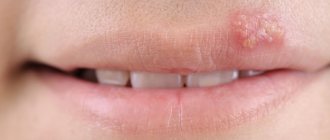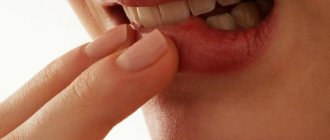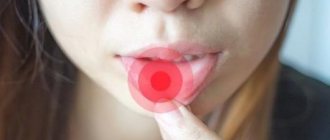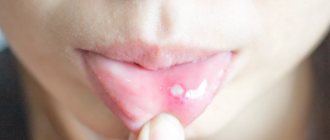A fairly common complaint that women go to the doctor with is acne on the labia.
Unfortunately, the term “pimple” is not a medical term and can include a number of very different conditions and manifestations.
In general, rashes on the genitals (pimples near the labia, in the groin and perianal area) are included in a separate group of symptoms.
Classified as genital lesions.
Pimples near the labia can be a sign of over a hundred different diseases.
Not all of which are related to sexually transmitted infections.
In addition, with some diseases, rashes can additionally be observed in the oral cavity and other parts of the body.
Rash elements of different types and manifestations are found with herpes, lice, impetigo, candidiasis, allergies, boils, STDs, etc.
As a result, even seemingly harmless lesions require referral to a specialist.
Regardless of which doctor, dermatovenerologist or gynecologist, will conduct an examination and prescribe the necessary studies and tests to identify the cause.
A correctly established diagnosis is the key to successfully getting rid of the problem.
Classification of rashes on the labia
Before answering the question of why acne appeared on the labia, for a correct assessment of the pathology process, it is important to be able to differentiate the elements that make up the rash.
According to dermatological terminology, primary ones are distinguished, appearing on unchanged skin.
And secondary elements, developing from primary ones.
Actually, in most situations, various types of acne on the labia belong specifically to the primary forms.
They are divided into cavity and cavityless.
Sometimes the transition from primary to secondary forms occurs very quickly.
In such a situation, knowledge of the specifics and patterns of transformation makes it possible to determine the type of previous education.
Primary elements include:
- A spot (artificial, non-inflammatory and inflammatory vascular, pigmented) is a limited change in skin color without cavities or elevations. Vascular formations of an inflammatory nature up to a centimeter in size are called roseola, from one to five centimeters - erythema. Examples include roseola syphilitica, erythematous variants of dermatitis, and toxicoderma. Possible secondary forms are secondary pigment spot, scale.
- A blister is a raised, cavity-free formation, the result of edema with acute inflammation in the papillary skin layer, which quickly appears/disappears. It can form due to urticaria, insect bites, and toxicoderma. Such itchy pimples on the labia are usually pink, less often whitish in the central zone, and may be accompanied by a burning sensation.
- Papules, otherwise known as nodules, are hollow, raised elements that usually pass without a trace. Such formations vary in size, depth, and can be inflammatory or non-inflammatory in nature. They may transform into cracks, scales, secondary pigment spots, lichenification (thickening, pigmentation disorders, deepening of the skin pattern). In some diseases, papules merge to form plaques.
- A tubercle is a hollow, raised, dense element up to a centimeter in size, which usually leads to the formation of scars and cicatricial atrophy. It can also develop into ulcers, growths, scales, and crusts. The formation lies deep in the skin and is observed in cases of tuberculosis, leishmaniasis, leprosy, and tertiary syphilis.
- A node is a hollow, raised element measuring over a centimeter (up to 10 cm). It may end without a trace or with the formation of a scar, ulcer, secondary pigment spot, or crust. Formed in the subcutaneous tissue. A subcutaneous pimple on the labia of inflammatory nature may turn out to be syphilitic gumma, a typical manifestation of tertiary syphilis. Non-inflammatory is formed due to the deposition of metabolic products (“pimple wen” on the labia) or as a result of neoplasms (lymphoma).
- A vesicle, otherwise known as a vesicle, is a cavitary single- or multi-chambered elevated formation, up to 5 mm in diameter, with a tire and a bottom. On the labia with genital herpes, watery pimples with serous contents appear on erythematous skin. Also, blisters on the labia are filled with serous-hemorrhagic contents (blood pimples). When the vesicles are opened, weeping erosions, scales, crusts, and secondary pigment spots may appear, but usually in the end there are no traces left on the skin.
- Bubble, bulla - differs in size from the bubble (its radius exceeds a quarter of a centimeter, and can even reach several centimeters). Resolves without a trace or with scarring. It is also possible to form erosions, scales, crusts, growths and age spots.
- Pustule, abscess - a cavitary deep or superficial raised formation with purulent contents (a pimple with pus is found on the labia). There are follicular, predominantly staphylococcal in nature, and non-follicular (superficial - phlyctena, deep - ecthyma), usually streptococcal. They can develop into crusts, erosions, spots, scars, ulcers, and growths. Follicular pustules form in the hair follicle, appearing on the labia as characteristic yellow pimples.
Secondary elements:
- scale – loosened horn cells in the form of a layer
- crust – drying contents of primary formations
- crack - a violation of the integrity of the skin that occurs due to a decrease in elastic properties
- abrasion - mechanical damage to the surface layer of skin
- erosion - a defect within the surface layer that appears when formations with a cavity are opened
- ulcer – deep skin defect
- scar - the formation of new connective tissue during the healing of skin defects
- cicatricial atrophy - cicatricial transformation without previous skin damage
- lichenification – thickening, dryness, compaction, staining, deepening of the skin pattern
- vegetation - growth of a skin area in an area of prolonged inflammation
- hyper- and hypopigmentation – weakening/increasing coloration of a skin area
How to get rid
It should be noted that there is no universal medication for acne. Bumps can form for many reasons. If neoplasms appear systematically, it is recommended to consult a specialist. The specialist will conduct a diagnosis and prescribe a treatment regimen aimed at combating a particular pathology.
Cosmetic procedures
Cosmetology salons offer the removal of white pimples on the lips through laser therapy. The goal of the procedure is to restore the aesthetic appearance of the lips.
The manipulation involves the following stages:
- The patient is seated in a special chair.
- A cosmetologist performs local anesthesia of the epithelial layer.
- The laser is applied.
- After the procedure is completed, an antiseptic bandage is applied.
In most cases, 2 procedures are required. Treatment depends on the area of the lesion. It takes a week for the tissue to completely recover. The new layer of epidermis does not contain acne and acquires a natural color.
Small pimples on the lip containing fat in the lip area do not degenerate into malignant tumors. The concentration of subcutaneous sebum in acne is low. Beauty salons offer 2 main methods for removing them. Each of them is used for specific clinical indications.
The table shows the main techniques:
| Method | Description |
| Cryodestruction | It is assumed that tumors will be burned out using low temperatures. A liquid nitrogen solution with a temperature of -195 °C is used. A solution of liquid nitrogen is precisely applied to the area of the lip. The dose of the substance is low, but this concentration is sufficient to eliminate the rash. After skin regeneration, the pimples disappear. |
| Plastic surgery | The procedure is indicated for patients who have developed acne with a diameter of more than 2 mm. Wen covers the entire surface of the lips, contributes to a decrease in the quality of life, and creates a cosmetic defect. Eliminating the tumor using laser and cryodestruction is impossible. The plastic surgeon removes the cyst capsule. Manipulation helps restore normal circulation of subcutaneous sebum in the ducts. The duration of the operation is 1.5-2 hours. Full recovery requires 2 weeks. General anesthesia is performed. |
The main disadvantage of cryodestruction and the surgical method is the likelihood of relapse of the pathology.
You can disguise pimples through permanent tattooing. The lip area is covered with paint. The procedure is contraindicated in case of exacerbation of herpes. For the purpose of prevention, a therapeutic course involving the use of antiviral drugs is required. Makeup is updated once every 2-3 years.
Causes of acne on the labia
There are several groups of diseases, the manifestation of which is acne on the labia (in adult women, in girls, in girls).
They can be triggered by infectious agents (bacteria, viruses, fungi), allergic reactions, autoimmune problems, tumor conditions.
Contribute to the appearance of a pimple on the labia:
- failure to comply with hygiene rules
- injury when shaving intimate areas, using irritants
- poor quality linen
- stress conditions, hypothermia, overheating
- decrease in the body’s defenses due to chronic pathology, pregnancy, due to taking certain medications, etc.
Homeopathic treatment for acne of all types
Along with traditional medications, homeopathy is considered more effective and faster in the treatment of pimples on the mucous membranes of various etiologies. The exceptional advantage of homeopathic medicines is the complete absence of side reactions , which often occur when using chemical medicines.
- Borax. Symptoms: burning pain, hot mouth, bleeding of the mucous membrane .
- Kalium bichromicum. Symptoms: deep aphthae, inflammation of the oral mucosa .
- Kalium muriaticum. Symptoms: acne, ulcers on the mucous membrane .
- Arsenicum. Symptoms: pimples that cause pain and discomfort .
- Apis mellifica. Symptoms: blistering acne .
- Rhus toxicodendron or poison sumac. Symptoms: herpes, blistering rashes .
- Thuja occidentalis or Western Thuja. Symptoms: herpes, white pimples .
When a symptom appears, you should not self-medicate , especially if it occurs frequently. For a complete cure, you should undergo a diagnosis and prescribe appropriate treatment .
Blisters on the labia
Blisters appear at the sites of insect bites (fleas, lice, etc.).
They are characterized by itchy rashes, the severity of which depends on the type of insect and the sensitivity of the bitten person.
Scratching the elements can lead to infection.
Spontaneous urticaria appears as itchy, sometimes burning, blisters.
The state is called:
- taking certain medications
- eating certain foods
- concomitant diseases (chronic gastrointestinal pathologies, diabetes, leukemia, etc.)
- pathological pregnancy, menopause, etc.
The elements first have a pale pink color, which becomes white as the swelling increases.
Usually such blisters disappear within 24 hours.
Ways to prevent the formation of pimples on the lip
It should be remembered that it is easier to prevent the onset of a disease than to deal with its source and symptoms later. To do this, it is enough to follow the recommended preventive measures, the main ones of which include:
- Control over the quality of food and cosmetic products consumed. Refusal to use products from dubious companies.
- Keep your immune system high by eating fiber-based foods. In addition, it is recommended to consume foods that have undergone minimal heat treatment and periodically take vitamin complexes.
Papules on the labia
Papules occur when:
- molluscum contagiosum
- secondary syphilis (characteristic is the absence of tangible symptoms - pain, itching, i.e. if a pimple hurts on the labia, this suggests another problem)
- Fox-Fordyce disease
- psoriasis
- folliculitis
- scabies
- lichen planus
- trichomycosis, etc.
Infection with molluscum contagiosum in adults occurs through sexual contact.
That is why the main place of localization of formations (unlike molluscum contagiosum in children) is the genitals and the areas around them.
In women, such a “pimple” is more often found on the labia majora, in the perianal area, and on the pubis.
The causative agent of the pathology is molluscum contagiosum virus type 2.
The incubation period varies from a couple of weeks to six months.
A typical element in women is a flesh-colored or pink rounded dense pimple on the labia, with a characteristic depression in the center of the nodule.
If an infected person accidentally or intentionally squeezes out a pimple of this kind, for example, on the labia, a white cheesy mass is released.
In some cases (often in HIV-infected people), a complication develops - the addition of a bacterial infection.
As a result, a “painful” pimple with pus and redness forms on the labia.
With relapse of secondary syphilis, papular syphilide often occurs.
These are densely elastic nodules in the genital area, anus, as well as on the palms and soles.
As a rule, such formations on the labia look like red pimples that are prone to cracking and peeling.
It is important to differentiate the disease from papular pseudosyphilis.
Then, due to hygienic violations, many pimples of a pale pink color, densely elastic consistency, similar to syphilides, form on the labia.
With Fox-Fordyce disease, women complain of severe itching, pimples on the labia, in the armpits, near the nipples, and on the pubis.
Such pimples on the outer labia are formed due to blockage of the ducts of the apocrine glands.
Quite often the condition worsens, the itching intensifies, and pimples on the labia grow before menstruation.
Interestingly, acne on the labia and other manifestations subside during pregnancy.
In postmenopause, regression of the disease can be expected.
In a situation where the labia is swollen, one pimple is located in pairs with another, there are characteristic scabies tracts, itching worsens at night, a diagnosis of scabies is likely.
With this pathology, scabious lymphoplasia can develop due to the body's response to the effects of waste products from mites.
That is, scabies looks like a hard pimple on the labia of considerable size.
A noticeable pinkish-red “blue” pimple with a purple, lilac tint on the labia is found in lichen planus, an autoimmune disease.
A pimple that appears on the labia after shaving is a manifestation of trichomycosis.
It is caused by aerobic corynobacteria in association with pigment-forming bacteria.
These are small pimples on the labia, usually yellow.
Less common, usually in tropical climates, are red and black pimples on the labia.
In the affected areas, sweat acquires a yellow color and a foul odor.
Papular rashes may be normal if:
- micropapillomatosis of the vulva
- seborrheic cysts (Fordyce granules)
- epidermal and pilar cysts
With micropapillomatosis of the vulva, the pimple is localized on the inner side of the labia.
Multiple symmetrical rashes (pinkish-white pimples) on the labia minora, rarely on the labia majora, occur during puberty.
The exact reason for their appearance is unknown.
A small soft pimple of the labia mucosa of a pinkish-flesh color is removed only for cosmetic purposes.
It is important to differentiate the formation from genital warts.
The characteristic distinguishing features are:
- symmetry of location (in condylomas it is chaotic)
- softness (condylomas are dense)
- no blanching in dough with acetic acid
An epidermal cyst is the most common cystic skin lesion.
It occurs when a cavity forms in the skin layer and fills it with horny masses and the production of the sebaceous glands.
Usually this is a single formation in the genital area, chest, face, upper back, neck.
The wall of the formation is thin and breaks easily.
If a pimple of this kind bursts on the labia, the cyst greatly increases in size and hurts.
A small epidermal cyst containing keratin is called a milia.
The formations look like white subcutaneous pimples with a predominant localization on the face.
In some cases, they appear on the labia and limbs.
They develop from the ducts of the sweat and sebaceous glands, hair follicles.
Seborrheic cysts are visible sebaceous glands, very small yellow-white formations.
Non-inflammatory papules with a villous surface, so-called. papulo-verrucous rashes are a sign of:
- anogenital warts
- condylomas lata with secondary syphilis
- bowenoid papulosis, etc.
Causes and symptoms of appearance
Causes of rashes in the lip area include:
- infection of the skin due to poor hygiene;
- inflammatory process in the facial nerve;
- hormonal imbalance;
- long-term use of drugs containing lithium and corticosteroids;
- dysfunction of the sebaceous glands;
- smoking;
- immune system failure;
- allergic reaction to cosmetics;
- sudden change in climatic conditions;
- lack of vitamins;
- pathologies of the gastrointestinal tract;
- presence of herpes;
- dermatological pathologies;
- functional disorders of the nervous system;
- disruption of hormone production by the pituitary gland;
- syphilis;
- stomatitis;
- tuberculous tissue sclerosis.
If the pimple disappears as quickly as it appeared, then there is no need to worry. You should contact a specialist if the tumor is persistent and cannot be eliminated by using over-the-counter medications.
Acne in the lip area may be accompanied by the following symptoms:
- pain when touched;
- redness;
- swelling;
- epithelial proliferation in the affected area;
- presence of cracks;
- increased dryness and flaking;
- secretion of ichor.
Initially, a small swelling forms and turns red. Then it quickly increases and becomes dense. When touched, a small core is felt inside. Then a cap is formed, under which an abscess matures. Once opened, the contents come out.
It is important to differentiate a simple neoplasm from serious pathologies that require timely treatment and pose a health hazard.
Genital warts on the labia
Anogenital warts, also called condylomas acuminata, are caused by the human papillomavirus.
They are formations of a characteristic appearance: their lobed structure makes them look like a cauliflower stalk.
Such a pimple forms inside the labia, near the vestibule of the vagina, anus.
There are also varieties with a smooth surface and the color of raw meat (papular warts).
Separately, there is a giant Buschke-Levenshtein condyloma, which can form during pregnancy or in people with reduced immunity.
It is important to differentiate genital warts from broad ones, manifestations of secondary syphilis.
The latter are a dense purple, red dark pimple with a wide base on the labia.
Bowenoid papulosis is a relatively rare disease.
It also occurs when infected during sexual contact with the human papillomavirus (type 16, high cancer risk group).
The main complaint of patients is that a flesh-colored, brown or red pimple has appeared in the pubic area, inguinal folds, perianal area, and on the labia.
Gradually, such papules merge into plaques with a warty surface.
Approximately 3% of cases of the disease result in malignancy.
What to do if pimples appear on your lips?
If you have pimples on your lips, you shouldn’t immediately run to the pharmacy for saving ointment. Despite popular misconception, the term “acne” does not refer to any specific disease. The rash can be a manifestation of many dermatoses. Only a specialist, having studied her character and collected anamnesis, will be able to prescribe adequate treatment.
With acne, inflammation around the lips is usually rare, but if the rash around the lips turns out to be acne, the doctor may prescribe topical antibiotics18. These include Clindovit® gel. Its main active ingredient is clindamycin phosphate, which upon contact with the skin is hydrolyzed to form clindamycin6. The drug is active against propionibacteria and helps reduce the level of free fatty acids6. To reduce the risk of developing antibiotic resistance, it is recommended to combine the use of Clindovit® with azelaic acid preparations (Azelik® gel) or benzoyl peroxide28.
Plaques on the labia
If a pimple appears on the labia, its size exceeds 1 cm, and in some cases, the skin in the affected area is thinned and whitened, we can talk about such primary elements as plaques.
Plaque lesions in women are typical for the following pathologies:
- neurodermatitis
- seborrheic keratosis
- lichen planus
- lupus erythematosus
- atopic dermatitis
- vulvitis candidiasis
- psoriasis
- Bowen's disease
- lichen sclerosus, etc.
With a disease such as candidal vulvitis (thrush), pimples on the labia and mucous membranes accompany the main manifestations.
These are curdled moderate/heavy discharge, swelling, redness.
Itching, which intensifies after sexual contact, a hygienic shower, during sleep, irritation, and a burning sensation in the perigenital area are also characteristic.
The problem is caused by the activity of yeast-like fungi of the genus Candida.
Lichen sclerosus - otherwise white spot disease, lichen sclerosus, vulvar kraurosis.
It appears in the form of clearly defined light spots, plaques, papules (“white pimples”) on the labia, in the inguinal folds, and vulva.
The formation of bloody blisters and erosions is possible.
Scarring often leads to fusion of the labia minora.
Bowen's disease is an intraepidermal formation (carcinoma) in the form of a sharply limited plaque with an uneven surface.
Usually detected in old age, it can develop into squamous cell carcinoma.
Localization Features
The nature of the location of the neoplasms provides an understanding of what served as the trigger for their development. Accurate diagnosis allows you to select a rational therapeutic regimen. Typically, pimples form under the skin on the inside and outside of the lips.
Under the skin from the inside
The location of white pimples usually indicates the development of an allergic reaction, especially in the absence of pain. The pathogen may be contained in cosmetics or other hygiene products. Diagnosis requires blood and urine tests. It is not recommended to determine the etiology from photographs on the Internet.
Lesions in the inner part of the oral cavity that are randomly located may indicate stomatitis. In this case, the person feels pain, itching and burning. Eating food and drinks provokes feelings of discomfort.
White pimples inside the mouth also form in smokers and people who do not follow hygiene standards. Often, abscesses or small ulcerations form on the inside of the lip.
The main signs of damage include:
- redness;
- discharge of pus;
- discomfort when eating;
- pain when touching the tongue;
- burning sensation.
If tumors develop in a child, you should consult a specialist. The defect may appear on the lip from below. It is usually painted white. The formation of multiple watery blisters is characteristic of stomatitis.
From the outside of the lips
When white pimples are found on the outside of the lips (along the line), herpes is usually diagnosed. New growths are characterized by wateriness. The rash develops very quickly.
The localization of small pimples in the corners of the mouth indicates a lack of vitamins, as well as an imbalance of hormones.
Small pimples caused by blockage of the sebaceous glands on the top of the lip represent wen. The surface of the neoplasm becomes covered with a crust. Pimples contain a yellow substance with a thick consistency. In the absence of therapy, an inflammatory process and suppuration may develop.
Pustules on the labia
Usually a pustule, otherwise a purulent pimple on the labia, does not exist for a very long period and may not even be noticed by the patient.
Superficial pustules quickly turn into crusts, while deep ones can form ulcers/erosions.
A group of dermatoses based on purulent inflammation of the skin is called pyoderma.
Pustular lesions are characteristic of:
- folliculitis
- impetigo
- hidradenitis
- syphiloid Sevestra-Jacquet and others.
Impetigo is a small superficial abscess with a convex red border.
The most common causes of the condition are staphylococci (80% of episodes) and streptococci.
A type of streptococcal impetigo in infants is post-erosive syphiloid Sevestra-Jaquet.
A problem arises with poor hygienic care for well-fed children as a result of the irritating effect of urine and feces.
Folliculitis is an inflammation of the hair follicle caused by bacteria, fungi, etc.
Deep folliculitis is called a boil.
Boils are inflamed, swollen pimples on the labia, cone-shaped with a necrotic core.
After the rod is separated, an ulcerative lesion develops in its place.
The recurrent appearance of numerous boils occurs with furunculosis.
A conglomerate of boils is called a carbuncle; it is a dense, up to 10 cm in diameter, node with pus.
Hidradenitis is a purulent inflammatory lesion of the apocrine glands that develops in the genital area, navel, anus, nipples, and axillary area.
In an infant, papulo-erosive streptoderma may appear on the labia, skin of the perineum, buttocks, and thighs - dense bluish-red pimples.
Why do pimples appear in the mouth?
Depending on the type of bacteria, viruses, infections and fungi affecting the mouth area, pimples of various colors and shapes may form in the place of the structure with compromised integrity. It should be noted that they can be the result of an irritating action of an external factor or have an inflammatory nature, this indicates a complication of the disease. Experts identify small pimples and pimples that are benign in nature and formations containing the dangerous HPV virus.
Different types of stomatitis
Stomatitis, as one of the diseases that affects the surface of the mucous membranes, is of a fungal nature and tends to expand the area of localization. Appearing initially in a limited space, a disease of this type over time forms conglomerates and colonies of pimples, which subsequently turn into ulcers covered with a white coating or containing watery/purulent inclusions.
- Stomatitis of a fungal nature manifests itself in the form of red pimples covered with white discharge of a cheesy consistency. Its appearance and development are facilitated by a decrease in the protective functions of the immune system and the presence of a sweet environment, for example, when breastfeeding a child. At the same time, the resulting dairy food residues create a favorable environment for the formation of acne.
- Bacterial stomatitis occurs when the body is exposed to bacteria such as streptococci and staphylococci. This type of disease usually develops against the background of a decrease in the body's resistance associated with the development of bacterial infections. The basis of therapy is the creation of conditions that prevent the development of bacteria and are aimed at destroying foci of localization of pathogenic microorganisms.
- Herpetic stomatitis manifests itself in the form of small watery pimples filled with purulent fluid inside, or ulcers with a white coating on the outside (we recommend reading: a pimple on the gum under a tooth: causes and methods of eliminating it). The main sign of this type of disease is an increase in the size of the lymph nodes and a slight increase in the patient’s body temperature.
Vesicles on the labia
Blistering formations, similar in appearance to “cold” pimples, on the labia and in the area of the vestibule of the vagina.
They are a sign of a viral infection – genital herpes.
This disease is caused by the herpes simplex virus and is prone to recurrence.
The typical form of the disease is characterized by itching, tingling, burning, and pain that precede the appearance of rashes.
The condition ends with the formation of crusts and areas of hyperpigmentation.
Chickenpox is an extremely contagious acute primary infection caused by a virus.
It is characterized by progressive rashes that appear in successive waves.
The disease is difficult to tolerate in adults and adolescents, newborns, and people with immunodeficiency.
In this case, rashes appear not only on the face and torso, but also in the mouth, on the labia.
They are a mixture of various elements, among which one can simultaneously identify itchy purulent large pimples, blisters, papules, and crusts.
Patients often complain that due to the fact that there are pimples on the mucous membrane and labia, it is painful to write and perform hygiene procedures.
Treatment methods for rashes
Most methods include therapy aimed at eliminating the cause of tumors, that is, eliminating a bacterial, viral or fungal infection. In addition, traditional methods of treatment are used, which are highly effective as independent remedies. However, more often they are prescribed as additional drugs that enhance the effect achieved when using medications.
At home
Existing folk methods of treating acne and rashes that occur in the oral cavity are highly effective as part of complex therapy, together with taking recommended medications and adjusting the diet. The most effective drugs include:
- Sea buckthorn oil, which is an excellent means of healing open wounds on the mucous membranes of the oral cavity.
- Propolis-based ointment with a wound-healing effect. It can be purchased at a pharmacy or prepared at home by mixing butter and pure propolis.
- When blisters appear on the inside of the lip, lotions and rinses with diluted calendula infusion are a good remedy.
- Treatment of the oral cavity after eating with a diluted solution of hydrogen peroxide. To obtain the drug, dilute 1 tbsp in a glass of water. hydrogen peroxide.
Medicines
Drug therapy and prescribed drugs will depend on the type of infection that has affected the patient’s body:
- General recommendations consist of a combination of antibacterial and antiviral drugs such as Zovirax and Acyclovir.
- In addition, it is necessary to use drugs that increase the body’s resistance, for example, vitamins A and B, and the complex drug Imudon.
- If there is pain in the affected area, these areas should be treated with local anesthetics.
- An important place in complex therapy is occupied by the use of wound healing and disinfectants. Drugs such as Metrogyl Denta ointment and Solcoseryl can effectively treat acne by affecting the localization of bacteria and viruses.
Other lesions on the labia
Bulla
A bulla is a huge pimple on the labia, a blister with a diameter of more than 5 mm.
Such formations in most situations are a symptom of serious skin lesions - bullous dermatoses.
For example, bullous pemphigoid is an autoimmune skin disease.
With it, itchy spots and papules first appear, and in their place blisters later develop, gradually turning into erosions.
tubercles
Tuberous dermatoses are rare.
Tend to progress to ulcerative formations with subsequent scarring.
They can be detected in cutaneous tuberculosis, pyogenic granuloma and tertiary forms of syphilis.
Nodes
Nodes are deeply located formations of dense consistency.
They do not exceed five centimeters in diameter and are rarely localized in the genital area.
Diseases manifested by the formation of nodes include:
- lymphangioma is a benign tumor that arises from the lymphatic vessels
- hidradenoma – benign tumor of the sweat gland
- lipoma – benign tumor of adipose tissue
- tertiary syphilis, etc.
A separate problem is pathologies in the area of the Bartholin glands.
They are located symmetrically at the base of the labia majora.
When the lumen of the gland is blocked, secretions accumulate in it and a cyst forms.
If infectious agents penetrate into the lumen, the development of bartholinitis (inflammation of the gland) and abscess (painful node with a purulent cavity) is possible.
Prevention of acne on the oral mucosa
To prevent blisters on the inside of the lip, first of all, you should take care of your personal hygiene. It is necessary to change your toothbrush regularly and avoid putting dirty hands into your mouth.
Proper nutrition plays the most important role among all. Everyone needs to exclude from their diet, at a minimum, quick snacks, and at a minimum, fatty and salty foods, alcoholic (alcoholic) and invigorating (energy) drinks, confectionery products containing a large number of calories. The Butek online store will help you switch to a healthy diet. It is becoming increasingly popular thanks to eco-products from famous European brands.
Various types of nuts (cashews, almonds, pistachios, etc.), ready-made breakfasts based on milk thistle, amaranth, rice, corn and flaxseed flour), muesli from elite durum wheat, natural marmalade, nut and fruit bars, candied fruits and chocolate honey (for those with a sweet tooth), natural oils, pasta and spelled porridge (a group of varieties of wheat, a unique natural source of antioxidants, mineral salts, proteins, healthy fats, etc.), herbal teas and drinks from natural fruits and vegetables, cutlets peas, lentils and white corn - this is an incomplete list of products that the Butek store offers.
All of them are made exclusively from natural ingredients and do not contain preservatives or artificial colors. With their help, you can not only improve the functioning of the gastrointestinal tract, strengthen the immune system, but also get rid of skin rashes, including acne on the oral mucosa.
What attracts the most is the Butekalife loyalty program. It consists of a system of accumulating points for purchased products, which can later be used to pay for future purchases.
Why an abscess is dangerous - causes and possible complications
Sometimes an abscess on the lip appears as a consequence of a banal microtrauma of the skin. In such a situation, the symptom can be provoked by insufficient oral hygiene and the penetration of bacteria into the open wound. However, in other cases, the formation of a painful neoplasm is caused by overheating or hypothermia, stress and fatigue, disturbances in the functioning of the liver and kidneys, disruptions in the functioning of the sebaceous and sweat glands, taking potent medications, and vitamin deficiency due to a weakened immune system1.
Any neoplasm on the skin or mucous membrane carries a potential danger if you ignore it or try to remove it yourself. So, for example, with the development of herpes, there is a risk of infection spreading to surrounding tissues, reaching the mucous membrane of the nasopharynx, eyes or genitals.
If the problem starts, serious complications can arise.
Inaction against the background of the development of stomatitis leads to an obvious deterioration of the patient’s condition and the development of complications. In the most severe cases, a boil on the upper lip risks leading to inflammation of the tissue near the defect, spreading the pathological process to the deep layers of the epidermis and even brain tissue. Against the background of a weakened immune system, a boil can develop into phlegmon or even an abscess. This is not a complete list of possible problems, so if suspicious symptoms appear, it is better to start treatment as quickly as possible.










